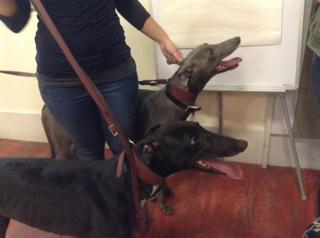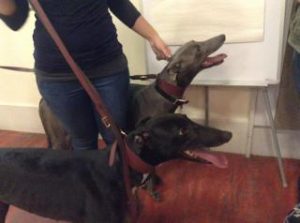This guest post is by Sessional Lecturer Nicole Holt
For the first time at Christ Church University, a lecture (in the second year forensic and investigative psychology module) was given on the use of dogs in forensics. The focus then moved onto the use of dogs in the court rooms. Not only that, two charming greyhound reading doggies in training came and joined us! (Thank you, Olivia Noble.)
The main uses of dogs in forensics and policing more generally include: sniffer dogs/drug detection, search and rescue, tracking, training, fieldwork, victim recovery, explosion detection, arson detection and, of course, most people’s favourite – therapy doggies which can be used in prisons, court rooms, waiting rooms, and counselling.
Dogs have been used by law enforcement agencies for over 100 years. Bloodhounds were used when searching for Jack the Ripper in 1888, and during that time they allowed canines to accompany police on patrol (Bell, 2004). However, more broadly, written recognition of the relationships of human–animal bonding dates to the 1700s in York, England, where the Society of Friends established a facility called The Retreat to provide humane treatment for the mentally ill. It was recognised that having patients care for the many farm animals on the estate would aid in the patients’ rehabilitation (Hart-Cohen, 2009). Furthermore, others throughout history note the benefits of dogs such as Florence Nightingale. This then eventually led onto the use of pet therapy animals being more widely accepted and charities set up to provide these facilities. This finally led to dogs being used in court rooms in America.
It would appear that one of the original courthouse dogs to aid young victims was a German shepherd named Vachss, used by the Children’s Advocacy Centre (CAC) in Jackson, Mississippi, USA, in the 1990s. In 1994 Vachss was presented with the Hero of the Year award for his role comforting children in the courtroom while they testified in abuse cases. The way in which a dog in the court room helps is that the dog tends rests at the victim’s feet during every interview and also sits with people outside the courtroom as they wait to testify. Some go up to the witness stand with a person and stands beside them at sentencing (Wallick, 2005). Sometimes people who are due to come to court go to see the dogs and bond with the dogs prior to attending.
Despite the growing success in America of using dogs in the courtroom, it is an area that has not been heavily explored within the UK. Therefore our next step is to explore the use of trained therapy/reading dogs in certain environments like court waiting rooms and, after our lecture, we have some keen students who are very willing to help us! We really feel this is an area which would be worth further exploration. We truly hope that in the next 20 years dogs will become a regular feature in UK courts across the country after all… it’s time our friends with paws had their day in court!
 psychology
psychology Marcus Roberts
Marcus Roberts 972
972






